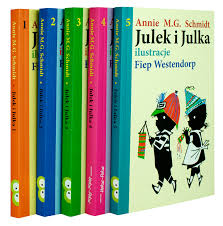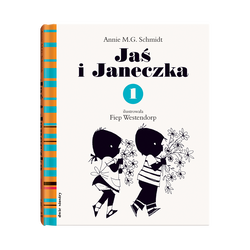Two Polish translations of "Jip en Janneke" by Annie M.G. Schmidt
The books Jip en Janneke became a popular reading choice for Dutch children, who have come to love the stories about two preschoolers. They are still often read today despite being written in the 1950s. Several decades later, the first translation appeared in Poland and quickly became a favourite book of many children and their parents.
The title characters in Jip en Janneke are preschool children who live next door to each other. The books are divided into short chapters in which the adventures of the main characters are told. The stories describe the typical everyday life of children who play a lot, at home or outdoors, sometimes argue, but after some time they always find a solution to their disagreements. These are very realistic stories with simple language, short dialogues and without any long descriptions. The books feature simple black illustrations, which have also been kept in the Polish translations. Although these books were written a long time ago, between 1953 and 1957, they are still very popular. The author of books is Annie M.G. Schmidt. She was a well-known Dutch writer who wrote not only children's books but also poetry and literature for adults. She received many awards, including the Hans Christian Andersen award for her entire literary output.
The book series Jip en Janneke are among the most popular children's books in the Netherlands. However, they were successful not only there, as they have been translated into many languages such as English, French and Turkish. In Poland the first translation appeared several decades after they were published in the Netherlands and they are still very popular with the youngest readers.
Polish translations of books

The covers of "Julek i Julka" series from the publishing house Hokus-Pokus.
Jip en Janneke were translated into Polish twice by two different translators which is quite unusual. The books were first published by the Hocus-Pocus publishing house and were entitled Julek i Julka. The first part of the stories was released in 2004 and the last one in 2010. This book was the beginning of the activities of this publishing house and it has been publishing children's literature ever since. The book was translated by the well-known Polish translator Łukasz Żebrowski. He has also translated books by such authors as Cees Nooteboom, Wolf Erlbruch, and texts written by the medieval writer Hadewijch. What is interesting is that he doesn’t usually translate children's literature. The books became popular in Poland and therefore further parts of the stories were published. The publishing house Hokus-Pokus organized events where Julek i Julka was promoted.
Not so long ago, in 2018, another translation of books was published, this time by the publishing house Dwie Siotry. The names of the main characters were changed to Jaś and Janeczka and within a few months all 5 books were published. They were translated by Maja Porczyńska-Szarapa. Another children's book translated by her is Rzeki (nl. Rivieren) by Peter Goes. The publishing house Dwie Siostry released audiobooks in which the stories are read by a well-known Polish actor Jarosław Boberek. The publisher has made fragments of audiobook recordings available on YouTube and short excerpts from the books are available to read on the publisher's website. As part of the promotion there were meetings with the translator where some of the stories from the books were read. You can also find a recording of Maja Porczyńska-Szarapa reading the stories on YouTube.

"Jaś i Janeczka" from the publishing house Dwie Siotry.
Both editions of the books appealed to the youngest readers and their parents. There are reviews of them available on the internet, most of which are very positive. As for the first translation, there are far fewer reviews probably due to the fact that it was published a long time ago. Readers mainly pay attention to the simple language in which the books are written, so that they can be easily understood by children. They also point out that it’s a great book for children who are just learning to read because of the way the books were written. People write that the stories are funny so they appeal to children and teach values such as respect and responsibility. Some parents think that black and white illustrations in books don’t encourage the purchase of books as this type of illustration is not typical of children's literature. Others believe that the illustrations emphasize the simplicity of the world presented in the books. A definite plus for some readers is that the second translation is published in hardback, on white paper and in a larger format.
Differences in translation and culture-specific items
Translating books that have already been translated into Polish must certainly have been a challenge. Some sentences are very similar or even the same. The translators took also different decisions on the translation of some words and titles of stories in the book. For example in Julek i Julka one of the titles is Niemowlę podobne do prosiaczka (literally: Piglet-like infant) and in Jaś i Janeczka it was translated as Dzidziuś jest podobny do świnki (literally: The baby is similar to a piggy). These titles do not differ much from each other, you could say that they are just synonyms but the meaning is a bit different. However, the differences in the whole text don’t affect the reception of the book.
One of the noticeable changes are of course different names of the main characters. Among readers of the previous translation arose a discussion because of the change of names of the main characters to which readers were used to. However, the change had to be made due to copyright laws that didn’t allow it to be left unchanged. But it was a good decision because readers also liked the new names due to their sound, which is closer to the original names and more fitting to the time in which the books were written.
One of the elements causing many problems during translation are culture-specific items. These are words describing, for example, the names of dishes, holidays or institutions. In children's literature the translator must be able to use such terms in a way that readers understand them. In the Polish translations of Jip en Janneke there are many such words and the translators have made different decisions regarding the translation of these terms.
Another element that was matched to a Polish culture are names. As mentioned earlier the names of the main characters were changed to Polish names. Other characters were also named differently e.g. auntie Mies became Hania (in Julek i Julka) and Monika (in Jaś i Janeczka). The cat which belongs to Janneke, that in the Dutch version of books is called Siepie, in the Polish translation is called Kruczek (in Julek i Julka) and Zuzia (in Jaś i Janeczka).
An integral part of the everyday lives of the characters in these books is playing. Several of different plays appear in the text and one of them is diefje (eng. thief). In a translation by Maja Porczyńska-Szarapa this game is called ‘zabawa w policjanta i złodzieja’ (playing policeman and thief). In this way it is more understandable for children from Poland, because the name that is in the Dutch text does not quite correspond to the Polish name for this game. It may be a small difference, but is closer to what children here know from their lives.
As I mentioned earlier, the names of the food are also often assigned to a particular culture. One such example are chocolade muisjes (literally chocolate mice) which are very well known in the Netherlands. It’s a chocolate sprinkle that is usually eaten on bread. In Poland they aren’t known by this name and they're not eaten the way they are there. In books it was translated as ‘wiórki czekoladowe’ (chocolate chips) and ‘posypka czekoladowa’ (chocolate sprinkles). In both cases the translators chose to describe the term so that it’s understandable to the Polish reader.
(Aleksandra Róziewicz)
